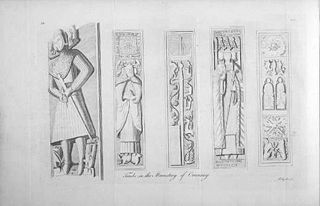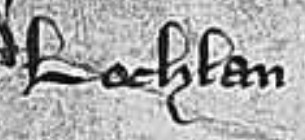Related Research Articles

Benbecula is an island of the Outer Hebrides in the Atlantic Ocean off the west coast of Scotland. In the 2011 census, it had a resident population of 1,283 with a sizable percentage of Roman Catholics. It is in a zone administered by Comhairle nan Eilean Siar or the Western Isles Council. The island is about 12 kilometres from west to east and a similar distance from north to south. It lies between the islands of North Uist and South Uist and is connected to both by road causeways. Benbecula's main settlement and administrative centre is Balivanich.

Barra is an island in the Outer Hebrides, Scotland, and the second southernmost inhabited island there, after the adjacent island of Vatersay to which it is connected by a short causeway. The island is named after Saint Finbarr of Cork.

The Lord of the Isles or King of the Isles (Scottish Gaelic: Triath nan Eilean or Rìgh Innse Gall) is a title of Scottish nobility with historical roots that go back beyond the Kingdom of Scotland. It began with Somerled in the 12th century and thereafter the title was held by a series of his descendants, the Norse-Gaelic rulers of the Isle of Man and Argyll and the islands of Scotland in the Middle Ages. They wielded sea-power with fleets of galleys (birlinns). Although they were, at times, nominal vassals of the Kings of Norway, Ireland, or Scotland, the island chiefs remained functionally independent for many centuries. Their territory included much of Argyll, the Isles of Arran, Bute, Islay, the Isle of Man, Hebrides, Knoydart, Ardnamurchan, and the Kintyre peninsula. At their height they were the greatest landowners and most powerful lords after the Kings of England and Scotland.
Arisaig is a village in Lochaber, Inverness-shire. It lies 7 miles south of Mallaig on the west coast of the Scottish Highlands, within the Rough Bounds. Arisaig is also the traditional name for part of the surrounding peninsula south of Loch Morar, extending east to Moidart. Etymologically, Arisaig means "safe bay". It lies in the Scottish council area of Highland and has a population of about 300.

Morar is a small village on the west coast of Scotland, 3 miles (5 km) south of Mallaig. The name Morar is also applied to the northern part of the peninsula containing the village, though North Morar is more usual. The coastline of the area forms part of the Morar, Moidart and Ardnamurchan National Scenic Area, one of 40 such areas in Scotland, which are defined so as to identify areas of exceptional scenery and to ensure its protection by restricting certain forms of development.

Castle Tioram is a ruined castle that sits on the tidal island Eilean Tioram in Loch Moidart, Lochaber, Highland, Scotland. It is located west of Acharacle, approximately 80 km (50 mi) from Fort William. Though hidden from the sea, the castle controls access to Loch Shiel. It is also known to the locals as "Dorlin Castle". The castle is a scheduled monument.
Moidart is part of the remote and isolated area of Scotland, west of Fort William, known as the Rough Bounds. Moidart itself is almost surrounded by bodies of water. Loch Shiel cuts off the eastern boundary of the district and continues along part of the southern edge. The remainder of the southern edge is cut off by Loch Moidart. The north is cut off by Loch Morar and Loch Ailort.

Clan Macdonald of Clanranald, also known as Clan Ranald or Clan Ronald, is a Highland Scottish clan and a branch of Clan Donald, one of the largest Scottish clans. The founder of the Macdonalds of Clanranald is Reginald, 4th great-grandson of Somerled. The Macdonalds of Clanranald descend from Reginald's elder son Allan and the MacDonells of Glengarry descend from his younger son Donald. The clan chief of the MacDonalds of Clanranald is traditionally designated as The Captain of Clanranald and today both the chief and clan are recognised by the Lord Lyon King of Arms, the heraldic judge in Scotland.

John of Islay was the Lord of the Isles (1336–1386) and chief of Clan Donald. In 1336, he styled himself Dominus Insularum, "Lord of the Isles"; although this was not the first ever recorded instance of the title in use. Some modern historians nevertheless count John as the first of the later medieval Lords of the Isles, although this rather broad Latin style corresponds roughly with the older Gaelic title Rí Innse Gall, in use since the Viking Age. For instance, the even more similar Latin title dominus de Inchegal, applied to Raghnall Mac Somhairle in the mid-12th century. In fact John is actually styled Rí Innsi Gall or King of the Isles shortly after his death in a contemporary entry in the Irish Annals of Ulster. Clan Donald considers the title "Lord of the Isles" to have been in use at least since Angus Mor Macdonald, who died in 1293. and the title "King of the Isles" in use since Somerled, the Norse-Gael who forged the Kingdom of the Isles in the 12th century.
Ruaidhrí mac Raghnaill was a leading figure in the Kingdom of the Isles and a member of Clann Somhairle. He was a son of Raghnall mac Somhairle, and was the eponymous ancestor of Clann Ruaidhrí. Ruaidhrí may have become the principal member of Clann Somhairle following the annihilation of Aonghus mac Somhairle in 1210. At about this time, Ruaidhrí seems to have overseen a marital alliance with the reigning representative of the Crovan dynasty, Rǫgnvaldr Guðrøðarson, King of the Isles, and to have contributed to a reunification of the Kingdom of the Isles between Clann Somhairle and the Crovan dynasty.

Domhnall mac Raghnaill was a Hebridean noble in the late 12th and early 13th centuries. He is the eponymous progenitor of Clan Donald. For this reason some traditions accumulated around him in the later Middle Ages and early modern period. His vast impact on culture and in the centuries remains today. Despite his role as the historical figurehead of one of the world's most famous kindreds and surnames, there is almost no contemporary evidence yielding certain information about his life.
The Rough Bounds, in the Scottish Highlands, is the area of West Inverness-shire bounded by Loch Hourn, Loch Shiel, and Loch Moidart, consisting of the districts of Knoydart, North Morar, Arisaig and Moidart. The area is famous for its wildness and inaccessibility and remains very sparsely populated.
Aonghus mac Somhairle was a leading member of Clann Somhairle. He was a son of Somhairle mac Giolla Brighde, King of the Isles and Ragnhildr Óláfsdóttir. Other sons of Somhairle and Ragnhildr include Dubhghall, Raghnall, and possibly Amhlaoíbh. Aonghus' father was the common ancestor of Clann Somhairle. The succession of this kindred upon Somhairle's death is uncertain. The Clann Somhairle imperium appears to have spanned from Glenelg in the north, to the Mull of Kintyre in the south. It is possible that Aonghus came to rule in the north, with Dubhghall centred in Lorne, and Raghnall in Kintyre and the southern islands.

Clann Ruaidhrí was a leading medieval clan in the Hebrides and the western seaboard of Scotland. The eponymous ancestor of the family was Ruaidhrí mac Raghnaill, a principal member of Clann Somhairle in the thirteenth century. Members of Clann Ruaidhrí were factors in both the histories of the Kingdom of the Isles and the Kingdom of Scotland in the thirteenth- and fourteenth centuries. The family appears to have held power in Kintyre in the thirteenth century. By the fourteenth century, the family controlled an extensive provincial lordship stretching along north-western Scottish coast and into the Hebrides. As a leading force in the Kingdom of the Isles, the family fiercely opposed Scottish authority. With the collapse of Norwegian hegemony in the region, the family nimbly integrated itself into the Kingdom of Scotland.
Amy of Garmoran also known as Amie MacRuari and Euphemia was a 14th-century Scottish noblewoman who was the sister of Raghnall mac Ruaidhri, Lord of Garmoran and the spouse of John of Islay. After her marriage had produced three sons, the ambitious John of Islay divorced her in order to remarry and cement his links with the House of Stewart. She then retired to her estates in the Highlands and Islands, and completed various ecclesiastical and other building projects. Her son Ranald was the progenitor of Clanranald.

Christina of the Isles was a fourteenth-century Scottish noblewoman. She was daughter of Ailéan mac Ruaidhrí, and a leading member of Clann Ruaidhrí. Although Ailéan had two sons, Lachlann and Ruaidhrí, both appear to have been illegitimate, whereas Christina was legitimate, and possibly a daughter of Ailéan's wife, Isabella.
Ranald MacDonald was the eponymous ancestor of the MacDonalds of Clanranald. He was a son of John MacDonald, Lord of the Isles, and his first wife Amie MacRory. John granted Ranald the lands of Garmoran, which he had acquired through his marriage to Amie. This grant may have been a form of compensation for Ranald's exclusion from the main inheritance of the family, which fell to Donald, the eldest son of John's second marriage. The Uists were later detached from Garmoran and given to Ranald's younger brother, Godfrey.
Raghnall Mac Ruaidhrí was an eminent Scottish magnate and chief of Clann Ruaidhrí. Raghnall's father, Ruaidhrí Mac Ruaidhrí, appears to have been slain in 1318, at a time when Raghnall may have been under age. Ruaidhrí himself appears to have faced resistance over the Clann Ruaidhrí lordship from his sister, Cairistíona, wife of Donnchadh, a member of the comital family of Mar. Following Ruaidhrí's demise, there is evidence indicating that Cairistíona and her powerful confederates also posed a threat to the young Raghnall. Nevertheless, Raghnall eventually succeeded to his father, and first appears on record in 1337.

Lachlann Mac Ruaidhrí was a Scottish magnate and chief of Clann Ruaidhrí. He was a free-booting participant in the First War of Scottish Independence, who remarkably took up arms against figures such as John, King of Scotland; Edward I, King of England; the Guardians of Scotland; and his near-rival William II, Earl of Ross. Lachlann disappears from record in 1307/1308, and appears to have been succeeded by his brother, Ruaidhrí, as chief of Clann Ruaidhrí.
Ruaidhrí Mac Ruaidhrí was a fourteenth-century Scottish magnate and chief of Clann Ruaidhrí. He was an illegitimate son of Ailéan mac Ruaidhrí, and is recorded to have participated in the kindred's military actions against supporters of both the English Crown and Scottish Crown. Following the apparent death of his brother, Lachlann, Ruaidhrí appears to have taken control of the kindred, and firmly aligned the family with Robert I, King of Scotland. Ruaidhrí may well be the member of Clann Ruaidhrí who is recorded slain at the Battle of Faughart in support of the Bruce cause in Ireland. After his death, Ruaidhrí's half-sister, Cairistíona, attempted to transfer the Clann Ruaidhrí territories outwith the family. Ruaidhrí was survived by a daughter, Áine, and an illegitimate son, Raghnall. The latter fended off Cairistíona's actions and succeeded to the chiefship of Clann Ruaidhrí.
References
- Barrow, G.W.S. (2003) The kingdom of the Scots: government, church and society from the eleventh to the fourteenth century. Edinburgh University Press
- Gregory, Donald (1881) The History of the Western Highlands and Isles of Scotland 1493 - 1625. Edinburgh. Birlinn. 2008 reprint - originally published by Thomas D. Morrison. ISBN 1-904607-57-8
- Hunter, James (2000) Last of the Free: A History of the Highlands and Islands of Scotland. Edinburgh. Mainstream. ISBN 1-84018-376-4
- Oram, Richard, "The Lordship of the Isles, 1336-1545", in Donald Omand (ed.) (2005) The Argyll Book. Edinburgh. Birlinn.